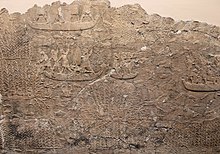Marsh Arabs
[4] Comprising members of many different tribes and tribal confederations, such as the Āl Bū Muḥammad, Ferayghāt, Shaghanbah, Ahwaris had developed a culture centered on the marshes' natural resources and unique from other Arabs.[7] Some scholars such as Ali al-Wardi have claimed they are descended from the Nabataeans of Iraq, the Aramaic-speaking people who inhabited Lower Mesopotamia in the Middle Ages, and some of their clans even follow their ancestry to Islamized Mandaeans.[8] Other scholars have proposed historical and genetic links between the Marsh Arabs and the ancient Sumerians due to shared agricultural practices, methods of house-building and location.By the mid-1980s, a low-level insurgency against Ba'athist drainage and resettlement projects had developed in the area, led by Sheik Abdul Kerim Mahud al-Muhammadawi of the Al bu Muhammad under the nom de guerre Abu Hatim.The plan, which was accompanied by a series of propaganda articles by the Iraqi regime directed against the Ma'dan,[12] systematically converted the wetlands into a desert, forcing the residents out of their settlements in the region.[16] However, following the Multi-National Force overthrow of the Saddam Hussein regime, water flow to the marshes was restored and the ecosystem has begun to recover, and many have returned to their native lands.[17] With the breaching of dikes by local communities subsequent to the 2003 invasion of Iraq and the ending of a four-year drought that same year, the process has been reversed and the marshes have experienced a substantial rate of recovery.Most of the rest that can be accounted for are refugees living in other Shi'i areas in Iraq, or have emigrated to Iran, and many do not wish to return to their former home and lifestyle, which despite its independence was characterised by extreme poverty and hardship.Though they often earned far more than workers in agriculture, weavers were looked down upon by both Ahwaris and farmers alike: however, financial concerns meant that it gradually gained acceptance as a respectable profession.Wilfred Thesiger mentioned that the Marsh Arabs who had performed the Hajj and those of them had visited Mashhad (thereby earning the title Zair) were considered highly respected within the community;[27] A number of families also claimed descent from Muhammad, adopting the title of sayyid.Ahwaris carried out the majority of their devotions in private as there were no places of worship within the Marshes; some were known to visit Ezra's Tomb, one of the few religious sites of any kind in the area.This, when labour required it, was thrown aside, and discovered forms most admirably adapted to their laborious avocations; indeed, any of the boatmen would have made an excellent model for an Hercules; and one in particular, with uncombed hair and shaggy beard, struck us all with the resemblance he bore to statues of that deity."Of the women Keppel observed, "They came to our boat with the frankness of innocence and there was a freedom in their manners, bordering perhaps on the masculine; nevertheless their fine features and well-turned limbs produced a tout ensemble of beauty, not to be surpassed perhaps in the brilliant assemblies of civilized life.[37] T. E. Lawrence had passed through in 1916, stopping at Basra and Ezra's Tomb (Al-Azair), and recorded that the Marsh Arabs were "wonderfully hard [...] but merry, and full of talk.





Ma'adanSouth Mesopotamian ArabicTwelverShia IslamArabicShroogMesopotamian ArabicMesopotamian marshlandsHawizeh MarshesIraq-Iran border.1991 uprisings in Iraq2003 invasion of IraqBritish colonialIndus ValleyPakistanZuṭṭAli al-WardiNabataeans of IraqAramaic-speakingLower MesopotamiaMiddle AgesMandaeansSumeriansbedouinAbbasid CaliphateDraining of the Mesopotamian MarshesSaddam HusseinslavesZanj RebellioninsurgencyBa'athistnom de guerreirrigationFirst Gulf WarTigris RiverEuphrates Riverfailed Shia uprisingBadr BrigadespropagandawetlandsdesertAkkadianIranianHammar MarshesCentral MarshesUnited NationsMulti-National ForceThe ObserverShyam BhatiaHammarecosystemMaysan GovernorateDhi Qar GovernorateBasra GovernorateUnited States Agency for International DevelopmentHezbollah Movement in IraqMuqtada al-Sadrkeffiyehturbanʻiqālwater buffaloesbarleypearl milletcattlePleiadesSiriusnomadicpastoralistsbarbeldaturaweavingagricultureMandaicWilfred ThesigerMashhadMuhammadsayyidEzra's Tombshaikhtributemudhifpoliticalsocialjudicialreligiousdiplomacyhospitalitycodes of behaviourmashoofislandtaradaschistosomiasismalariaPietro Della ValleGavin YoungGeorge Keppel, 6th Earl of AlbemarleGertrude BellT. E. LawrenceGavin MaxwellS. M. SalimethnoarchaeologicalUniversity of Pennsylvania Museum of Archaeology and AnthropologyRory StewartThe Prince of the MarshesDawn of the WorldAbbas FahdelMohammad Reza FartousiAmer AlwanGenetic history of the Middle EastHaplogroup J-M267haplogroup JTigris–Euphrates river systemShatt al-ArabEdward BawdenShrougAl-DurajiAl-MuntafiqWayback MachineJuan ColeUniversity of IndianaRobert FiskUnited Nations Environment ProgrammeNewcastle UniversityPitt Rivers MuseumDeutsche WelleDemographics of Iraq